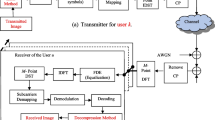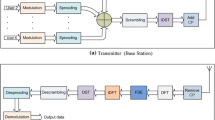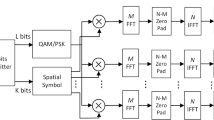Abstract
Single carrier frequency division multiple access (SC-FDMA) has become increasingly popular in broadband data transmission systems due to its many advantages. One of the main advantages is the lower peak-to-average power ratio (PAPR), which significantly benefits the mobile terminal station in terms of transmit power efficiency. However, SC-FDMA is susceptible to carrier frequency offsets (CFOs) which affect the orthogonality between subcarriers and cause inter-carrier interference (ICI) and multiple access interference (MAI). In this paper, we analyze and evaluate the performance of SC-FDMA in the presence of CFOs for wireless image transmission with different basis functions, different subcarrier mapping techniques, and different modulation schemes over vehicular A and SUI3 channel models. This study focuses on evaluating the performance of SC-FDMA using wireless image transmission. The evaluation is conducted based on two performance metrics, namely peak signal-to-noise ratio (PSNR) and mean square error (MSE). Specifically, we consider the following three cases: the no CFOs case, the case when CFOs are present but without compensation, and the case when CFOs are present and CFO compensation is used. The CFO compensation technique used in this work is the joint mean minimum squared error (JMMSE) method. The results showed that JMMSE with DFT can provide better performance in the presence of CFOs compared to DCT and DST. Additionally, the choice of interleaved subcarrier mapping technique provides better performance compared to localized subcarrier mapping. Furthermore, the impact of the modulation scheme and the channel model on system performance is also evaluated, with the results showing that QPSK is more robust to CFOs compared to 16QAM modulation and the performance is better transmitting over the SU13 model rather than the vehicular A channel model. Simulation results demonstrate the effectiveness of JMMSE combined with DFT and interleaved subcarrier mapping in mitigating the effects of CFOs and multipath channels, especially with the SUI3 channel model and QPSK modulation.






















Similar content being viewed by others
Data Availability
The data in this study is available from the corresponding author upon request.
References
Farhang-Boroujeny B, Moradi H (2016) OFDM inspired waveforms for 5G. IEEE Commun Surv Tutor 18(4):2474–2492
Moles-Cases V, Zaidi AA, Chen X, Oechtering TJ, Baldemair R (2017) A comparison of OFDM, QAM-FBMC, and OQAM-FBMC waveforms subject to phase noise. In: 2017 IEEE International conference on communications (ICC). IEEE, pp 1–6
Zyren J, McCoy W (2007) Overview of the 3G PP long term evolution physical layer. Freescale Semiconductor Inc White Paper 7:2–22
Wu M, Yin B, Wang G, Dick C, Cavallaro JR, Studer C (2014) Large-scale MIMO detection for 3G PP LTE: algorithms and FPGA implementations. IEEE J Sel Topics Signal Process 8(5):916–929
Abd El-Samie FE, Al-Kamali FS, Al-Nahari AY, Dessouky MI (2013) SC-FDMA for mobile communications. CRC press, ???
Kumar S, Chaudhari MS, Gupta R, Majhi S (2020) Multiple CFOs estimation and implementation of SC-FDMA uplink system using oversampling and iterative method. IEEE Trans Veh Technol 69(6):6254–6263
Raghunath K, Chockalingam A (2009) SC-FDMA versus OFDMA: sensitivity to large carrier frequency and timing offsets on the uplink. In: GLOBECOM 2009-2009 IEEE global telecommunications conference. IEEE, pp 1–6
Nair LR, Pillai SS (2022) A low complexity CFO reduction technique for LFDMA systems. In: International conference on information, communication and computing technology. Springer, pp 30–41
Gupta R, Kumar S, Majhi S (2020) Blind modulation classification for asynchronous OFDM systems over unknown signal parameters and channel statistics. IEEE Trans Veh Technol 69(5):5281–5292
Iqbal N, Zerguine A, Al-Dhahir N (2015) CFO mitigation using adaptive frequency-domain decision feedback equalization for uplink SC-FDMA. In: 2015 49th Asilomar conference on signals, systems and computers. IEEE, pp 1157–1160
Lee K, Lee S-R, Moon S-H, Lee I (2012) MMSE-based CFO compensation for uplink OFDMA systems with conjugate gradient. IEEE Trans Wirel Commun 11(8):2767–2775
Mostafa M, Newagy F, Hafez I (2016) Joint complex regularised zero-forcing equalisation and CFO compensation for MIMO SC-FDMA systems. IET Commun 10(16):2245–2251
Wilzeck A, Cai Q, Schiewer M, Kaiser T (2007) Effect of multiple carrier frequency offsets in MIMO SC-FDMA systems. In: Proceedings of the international ITG/IEEE workshop on smart antennas. pp 1–7
Al-Kamali FS, Dessouky MI, Sallam BM, Shawki F, Al-Hanafy W, Abd El-Samie FE (2012) Joint low-complexity equalization and carrier frequency offsets compensation scheme for MIMO SC-FDMA systems. IEEE Trans Wirel Commun 11(3):869–873
Li M, Rui Y (2009) Analysis of CFO effects on and phase compensation method for SC-FDMA systems. Sci China Series F Inf Sci 52(12):2397–2405
Al-kamali FS, Dessouky MI, Sallam BM, Shawki F, Abd El-Samie FE (2012) Equalization and carrier frequency offsets compensation for the SC-FDMA system. Wirel Pers Commun 67:113–138
Al-Kamali FS, Qasem AA, Abuasbaa SA, Qasem GA (2016) SC-FDMA and OFDMA: an efficient wireless image transmission schemes. J Control Syst Eng 4(1):74–83
Elbehery A, Abdelwahab S, Abd El Naby M, Hassan E, Elaraby S (2013) C3. image transmission with DCT based SC-FDMA system using continuous phase modulation. In: 2013 30th national radio science conference (NRSC). IEEE, pp 149–157
Padmapriya V (2018) Image transmission in 4G LTE using DWT based SC-FDMA system. Biomed Pharmacol J 11(3):1633
Allah F, Soliman N, Abdalla M, El-Samie A et al (2021) Efficient transmission of watermarked images with SC-FDMA. Menoufia J Electron Eng Res 30(2):17–27
Al-soufy K, Al-kamali F, Al-Fuhaidy F (2017) Performance evaluation of SC-FDMA systems using wireless images. American Journal of Computer Sciences and Applications (ISSN: 2575-775X), Research Article, AJCSA
Al-kamali FS, Al-Soufy KA (2021) Carrier frequency offsets problem in recent DST-SC-FDMA system: investigation and compensation. J Eng 2021(7):366–379
Al Soufy KA (2018) An efficient transmission of image over SC-FDMA system in the presence of CFO. J Commun Technol Electron Comput Sci 18:8–18
Al-Soufy KAM, Al-kamali FS (2023) Evaluation of orthogonal frequency-division multiple-access systems in the presence of carrier frequency offset using wireless images transmission. IET Commun
Al-kamali FS, Dessouky MI, Sallam BM, Abd El-Samie FE (2009) Performance evaluation of cyclic prefix CDMA systems with frequency domain interference cancellation. Digit Signal Process 19(1):2–13
Al-kamali FS, Dessouky MI, Sallam BM, Shawki F, El-Samie A, Fathi E (2011) Carrier frequency offsets problem in DCT-SC-FDMA system: investigation and compensation. Int Sch Res Notices 2011
Tan P, Beaulieu NC (2006) A comparison of DCT-based OFDM and DFT-based OFDM in frequency offset and fading channels. IEEE Trans Commun 54(11):2113–2125
Acknowledgements
This work was made using the facilities of the Department of Physics, AUC, Cairo, Egypt, and it was possible by a fellowship awarded from Scholar Rescue Fund-IIE. The statements made herein are solely the responsibility of the authors.
Author information
Authors and Affiliations
Contributions
K. A. M. and F.S. writing—original draft, data curation, visualization, analyzing the collected articles. C. D. helped in writing and editing the final draft. N. H. N. helped in editing. F. M. N. helped in the analysis. M.A.S.: conceptualization, supervision, project administration, review. All the authors contributed to the general discussion and revision of the manuscript.
Corresponding author
Ethics declarations
Conflict of interest
The authors declare no competing interests.
Additional information
Publisher's Note
Springer Nature remains neutral with regard to jurisdictional claims in published maps and institutional affiliations.
Rights and permissions
Springer Nature or its licensor (e.g. a society or other partner) holds exclusive rights to this article under a publishing agreement with the author(s) or other rightsholder(s); author self-archiving of the accepted manuscript version of this article is solely governed by the terms of such publishing agreement and applicable law.
About this article
Cite this article
Al Soufy, K.A.M., Al-Kamali, F.S., D’Amours, C. et al. Performance evaluation of DFT/DCT/DST-based SC-FDMA systems in the presence of CFOs for wireless images transmission. Ann. Telecommun. (2024). https://doi.org/10.1007/s12243-024-01020-w
Received:
Accepted:
Published:
DOI: https://doi.org/10.1007/s12243-024-01020-w




